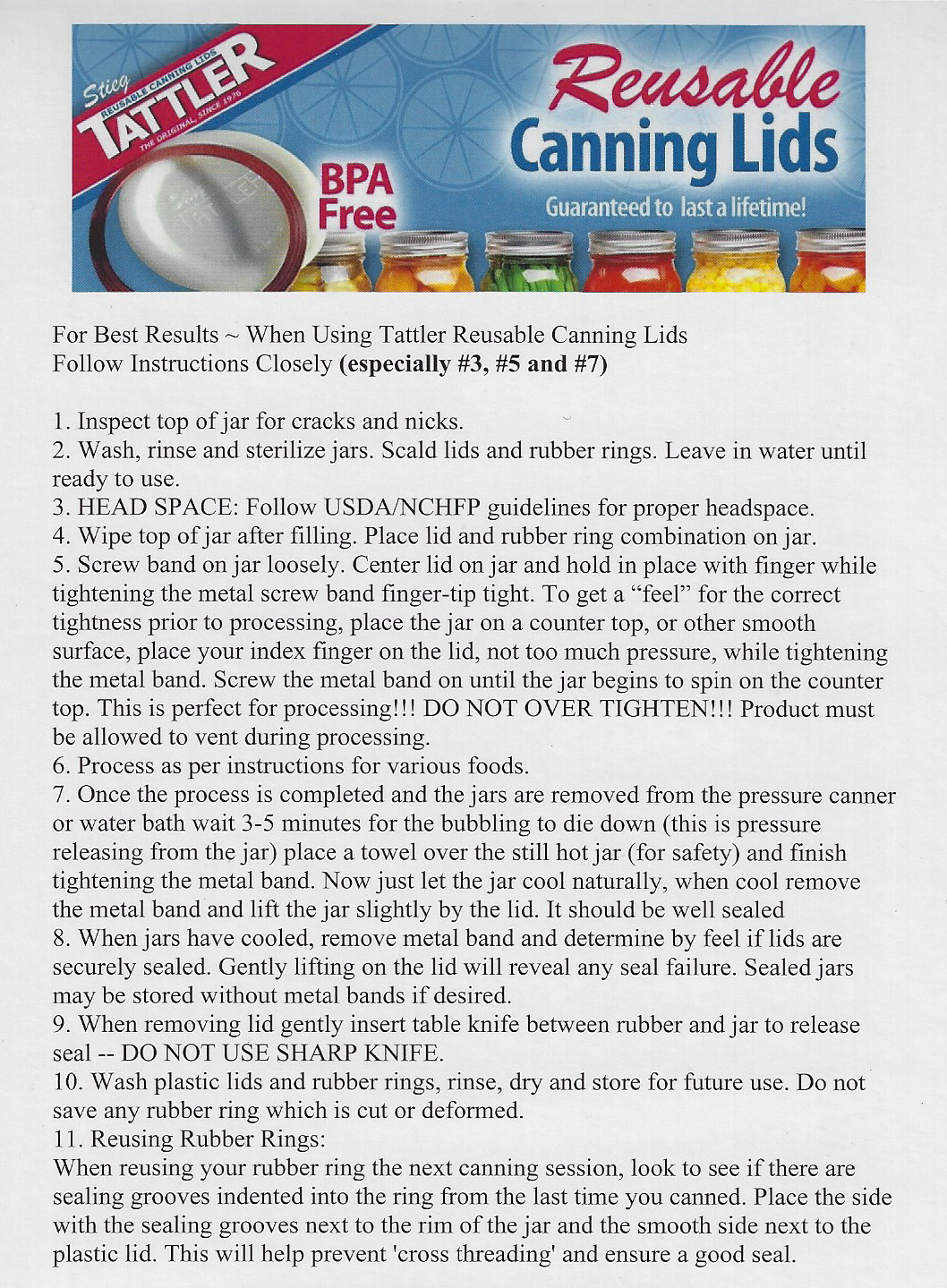Information
Tattler Lids do require a bit of variation from conventional metal lids. Being a two piece combination with a rubber gasket ring, Tattler Lids must remain a bit loose during processing in order for the jar to vent the pressure that has built in the jar during processing. An online customer gave us a very good tip on how tight is 'Just Right'. To get the feel for the correct tightness prior to processing, place the jar on a counter top or other smooth surface, then place your index finger on the lid (do not apply too much pressure while tightening the metal band). Screw the metal band on until the jar begins to spin on the counter top (or other smooth surface). This is the perfect tightness for processing!
THE FOLLOWING FINAL STEP IS CRUCIAL TO ENSURE A GOOD SEAL: Once the process is completed and the jars are removed from your canner, Let the bubbling die down (approximately 3-5 minutes), as this is pressure still releasing from the jars. Place a towel over the still hot jars (for safety) and finish tightening the metal bands. Now, let your jars cool naturally and when cool to room temperature, remove the metal band and lift the jar slightly by the lid. It should be well sealed. Your food is ready for storing (store without metal screw bands).

Additional Insight
Are TATTLER Reusable Canning Lids Safe?
In one single word, YES! TATTLER Reusable Plastic Canning Lids are manufactured using a plastic compound that is safe for direct contact with food products. We utilize an FDA and USDA approved, food grade product known as Polyoxymethylene Copolymer (POM) or Acetal Copolymer.
The rubber rings (gaskets) are made from a food grade nitrile rubber and contain no latex.
Neither formulation contains any Bisphenol A (BPA) or phthalates!
TATTLER Reusable Plastic Canning Lids are manufactured using a plastic compound that is safe for direct contact with food products.We utilize an FDA and USDA approved, food grade product known as Polyoxymethylene Copolymer (POM) or Acetal Copolymer.
The product we use is compliant with applicable FDA regulations for food contact subject to the limitations listed below. This product is formulated using polyacetal base resin that is compliant for use in food contact applications according to (CFR), Title 21, 177.2470. Any additives, that may be present, comply with appropriate, specific FDA Regulations.
Limitations:
Types of food: All types of food except foods containing 15% or more alcohol.Conditions of Use: Use temperature not to exceed 250 deg F per 177.2470.
Additionally, this plastic is approved by the USDA for direct contact use with meat and poultry products, as well as meeting the Sanitary Standards 3A Compliance for the Dairy and Food Industries Supply Association (DFISA).
What about Formaldehyde?
Many questions have been asked about the existence of formaldehyde in Acetal Copolymer. While it is true formaldehyde is present in trace amounts, research proves it is only released at very high temperatures, well above any temperatures found in home food canning. Here are the facts.
Heating our brand of acetal copolymer above 460 degrees F (238 C) should be avoided. At these temperatures, formaldehyde, a colorless and irritating gas that can be harmful in high concentrations, is generated.
What about the Recycle Symbol on the Lids?
Numerous inquiries have been made regarding the Number 7 recycling symbol found on Tattler Reusable Canning Lids. Many people believe the presence of this symbol contradicts the claim that our product is BPA Free, and all products contained within this category leach toxic chemicals. Both of these beliefs are incorrect.
There are 7 classifications of recyclable materials, the last of which Tattler Reusable Canning Lids fall within due to its "Other" classification. Each of the previous 6 categories is very specific as shown in the following definitions listing. The Number 7 category includes all "other" products that do not fall into the previous 6 specific categories. Plastics which contain BPA do fall into Class 7, but the presence of the symbol DOES NOT automatically mean that all products in the category contain BPA.
PET or PETE: Polyethylene Terephthalate - PET is commonly used for soft drink & water bottles, cooking oil bottles, peanut butter containers. It is the most widely recycled plastic.HDPE: High-Density Polyethylene - Identifies milk, cider & water jugs, detergent, fabric softener & bleach bottles. HDPE is slightly waxy and semi-rigid. It does not crack. It floats in water.PVC: Polyvinyl Chloride - Also abbreviated V, PVC is used in salad dressing bottles, vegetable oil bottles and mouthwash bottles. PVC is smooth, scratches easily and sinks in water.LDPE: Low-Density Polyethylene - LDPE is used in flexible bags for dry cleaning, trash, produce, bread and shrink wrap. Recycled LDPE is often used to make grocery bags.PP: Polypropylene - PP is usually is found in drinking straws, battery cases, some dairy tubs, bottles labels and caps, and rope. PP stretches into filaments and emits a chemical smell when burned.PS: Polystyrene - PS and Expanded Polystyrene (EPS) both are No. 6 plastics. PS and EPS are commonly used in packaging peanuts and other packaging materials and in plastic utensils, meat and egg trays. PS sinks in water; EPS floats.Other - Other plastics often are made of multiple resins or layers of different types of plastics. These may include microwave packages, snack bags and industrial plastics.